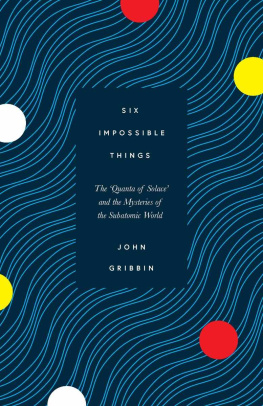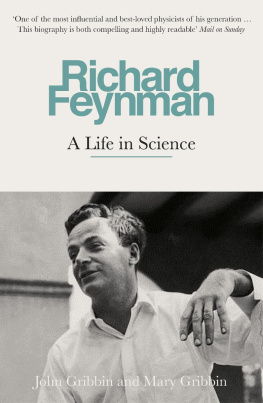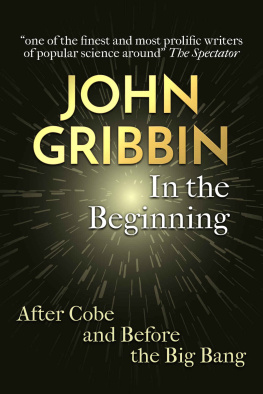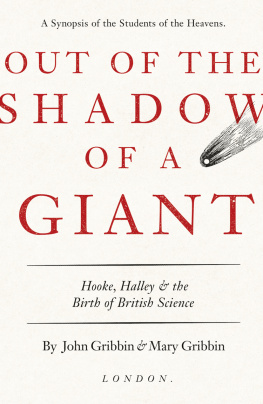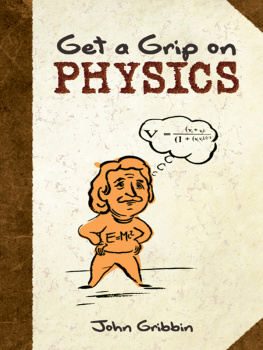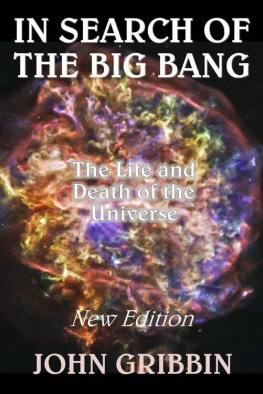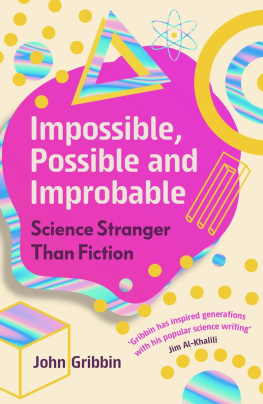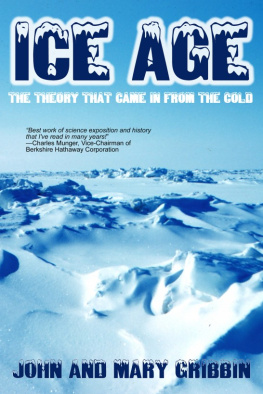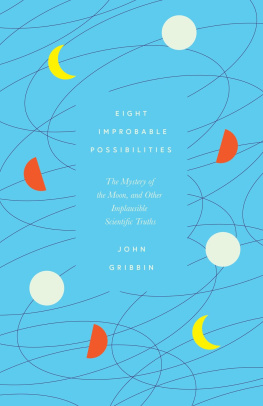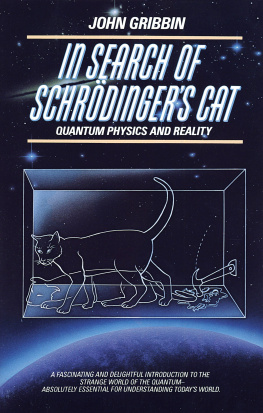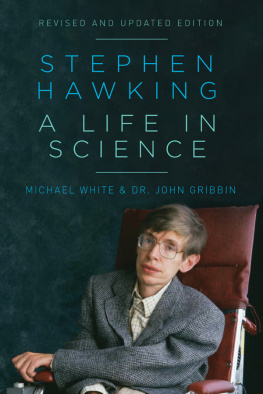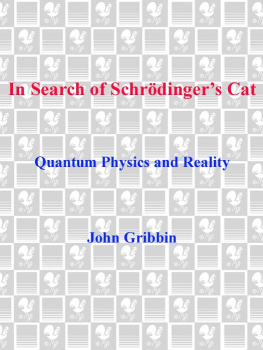John Gribbin - Six Impossible Things: The ’Quanta of Solace’ and the Mysteries of the Subatomic World
Here you can read online John Gribbin - Six Impossible Things: The ’Quanta of Solace’ and the Mysteries of the Subatomic World full text of the book (entire story) in english for free. Download pdf and epub, get meaning, cover and reviews about this ebook. year: 2019, publisher: Icon, genre: Science. Description of the work, (preface) as well as reviews are available. Best literature library LitArk.com created for fans of good reading and offers a wide selection of genres:
Romance novel
Science fiction
Adventure
Detective
Science
History
Home and family
Prose
Art
Politics
Computer
Non-fiction
Religion
Business
Children
Humor
Choose a favorite category and find really read worthwhile books. Enjoy immersion in the world of imagination, feel the emotions of the characters or learn something new for yourself, make an fascinating discovery.
- Book:Six Impossible Things: The ’Quanta of Solace’ and the Mysteries of the Subatomic World
- Author:
- Publisher:Icon
- Genre:
- Year:2019
- Rating:5 / 5
- Favourites:Add to favourites
- Your mark:
- 100
- 1
- 2
- 3
- 4
- 5
Six Impossible Things: The ’Quanta of Solace’ and the Mysteries of the Subatomic World: summary, description and annotation
We offer to read an annotation, description, summary or preface (depends on what the author of the book "Six Impossible Things: The ’Quanta of Solace’ and the Mysteries of the Subatomic World" wrote himself). If you haven't found the necessary information about the book — write in the comments, we will try to find it.
Six Impossible Things: The ’Quanta of Solace’ and the Mysteries of the Subatomic World — read online for free the complete book (whole text) full work
Below is the text of the book, divided by pages. System saving the place of the last page read, allows you to conveniently read the book "Six Impossible Things: The ’Quanta of Solace’ and the Mysteries of the Subatomic World" online for free, without having to search again every time where you left off. Put a bookmark, and you can go to the page where you finished reading at any time.
Font size:
Interval:
Bookmark:
IMPOSSIBLE
THINGS
The Quanta of Solace
and the Mysteries of
the Subatomic World
JOHN
GRIBBIN

Alice laughed: Theres no use trying, she said; one cant believe impossible things.
I daresay you havent had much practice, said the Queen. When I was younger, I always did it for half an hour a day. Why, sometimes Ive believed as many as six impossible things before breakfast.
Alices Adventures in Wonderland
SOLACEn. (pl. -es) comfort or consolation in a time of great distress.
PREFACE
Q uantum physics is strange. At least, it is strange to us, because the rules of the quantum world, which govern the way the world works at the level of atoms and subatomic particles (the behaviour of light and matter, as Richard Feynman put it), are not the rules that we are familiar with the rules of what we call common sense.
The quantum rules seem to be telling us that a cat can be both alive and dead at the same time, while a particle can be in two places at once. Indeed, that particle is also a wave, and everything in the quantum world can be described entirely in terms of waves, or entirely in terms of particles, whichever you prefer. Erwin Schrdinger found the equations describing the quantum world of waves, Werner Heisenberg found the equations describing the quantum world of particles, and Paul Dirac proved that the two versions of reality are exactly equivalent to one another as descriptions of that quantum world. All of this was clear by the end of the 1920s. But to the great distress of many physicists, let alone ordinary mortals, nobody (then or since) has been able to come up with a common sense explanation of what is going on.
One response to this has been to ignore the problem, in the hope that it will go away. The equations (whichever version you prefer) work if you want to do things like design a laser, explain the structure of DNA, or build a quantum computer. Generations of students have been told, in effect, to shut up and calculate dont ask what the equations mean, just crunch the numbers. This is the equivalent of sticking your fingers in your ears while going la-la-la, I cant hear you. More thoughtful physicists have sought solace in other ways. They have come up with a variety of more or less desperate remedies to explain what is going on in the quantum world.
These remedies, the quanta of solace, are called interpretations. At the level of the equations, none of these interpretations is better than any other, although the interpreters and their followers will each tell you that their own favoured interpretation is the one true faith, and all those who follow other faiths are heretics. On the other hand, none of the interpretations is worse than any of the others, mathematically speaking. Most probably, this means that we are missing something. One day, a glorious new description of the world may be discovered that makes all the same predictions as present-day quantum theory, but also makes sense. Well, at least we can hope.
Meanwhile, I thought it might be worth offering an agnostic overview of some of the main interpretations of quantum physics. All of them are crazy, compared with common sense, and some are more crazy than others, but in this world crazy does not necessarily mean wrong, and being more crazy does not necessarily mean more wrong. I have chosen six examples, the traditional half-dozen, largely in order to justify using the quotation from Alice. I have my own views on their relative merits, which I hope I shall not reveal, leaving you to make your own choice or, indeed, to stick your fingers in your ears while going la-la-la, I cant hear you.
Before offering those interpretations, though, I ought to make it clear just what it is we are trying to interpret. Science often proceeds in fits and starts. In this case, though, it seems appropriate to begin, with another nod to Charles Lutwidge Dodgson, with two fits.
John Gribbin
June 2018
FIT THE FIRST
T he weirdness of the quantum world is encapsulated in what is formally known as the double-slit experiment. Richard Feynman, who was awarded the Nobel Prize for his contributions to quantum physics, preferred to call it the experiment with two holes, and said that it is a phenomenon which is impossible, absolutely impossible, to explain in any classical way, and which has in it the heart of quantum mechanics. In reality, it contains the only mystery the basic peculiarities of all quantum mechanics. This may come as a surprise to anyone who only remembers the experiment from school physics, where it is used to prove that light is a form of wave.
The school version of the experiment involves a darkened room in which light is shone on to a simple screen a sheet of card or paper in which there are two pinholes, or in some versions two narrow parallel slits. Beyond this screen there is a second screen, without any holes. Light from the two holes in the first screen travels across to the second screen, where it makes a pattern of light and shade. The way light spreads out from the two holes is called diffraction, and the pattern is called an interference pattern, because it is the result of two beams of light, one from each of the two holes, spreading out and interfering with each other. And it exactly matches the pattern you would expect if light is travelling as a form of wave. In some places, the waves add together and make a bright patch on the second screen; in other places the peak of one wave coincides with the trough of the other wave, so they cancel each other out to leave a dark patch. You can see exactly the same kind of interference pattern in the ripples produced on a still pond if you drop two pebbles into it at the same time. One of the distinctive features of this kind of interference is that the brightest patch of light on the second screen is not directly behind either of the two holes, but exactly halfway between those points, just where, if light was actually a stream of particles, you would expect the second screen to be completely dark. If light was made of a stream of particles, you would expect to see a bright patch behind each hole, and darkness in between those patches of light.

Richard Feynman
Getty Images

When light passes through two slits in a screen, waves spread out from each slit to make an interference pattern, like ripples on a pond.
So far, so good. This proves that light travels as a wave, as Thomas Young realised at the beginning of the nineteenth century. Unfortunately, at the beginning of the twentieth century another kind of experiment showed light behaving as a stream of particles. These experiments involved electrons being knocked out of a metal surface by a beam of light the photoelectric effect. When the energy of the ejected electrons was measured, it turned out that for any given colour of light the energy of each electron was always the same. For a bright light there are more electrons ejected, but they still all have the same energy as each other, and this is the same as the energy of each of the smaller number of electrons ejected when the light is dimmed. It was Albert Einstein who explained this in terms of particles of light, what we now call photons or in his language, quanta of light. The amount of energy carried by a photon depends on the colour of the light, but for any colour all photons have the same energy. As Einstein put it, the simplest conception is that a light quantum transfers its entire energy to a single electron. Turning up the light just provides more photons (light quanta), each with the same energy to give to the electrons. It was for this work, not his theories of relativity, that Einstein was awarded the Nobel Prize. After a hundred years of thinking of light as a wave, physicists had to start thinking of it as a particle but how could that explain the experiment with two holes?
Font size:
Interval:
Bookmark:
Similar books «Six Impossible Things: The ’Quanta of Solace’ and the Mysteries of the Subatomic World»
Look at similar books to Six Impossible Things: The ’Quanta of Solace’ and the Mysteries of the Subatomic World. We have selected literature similar in name and meaning in the hope of providing readers with more options to find new, interesting, not yet read works.
Discussion, reviews of the book Six Impossible Things: The ’Quanta of Solace’ and the Mysteries of the Subatomic World and just readers' own opinions. Leave your comments, write what you think about the work, its meaning or the main characters. Specify what exactly you liked and what you didn't like, and why you think so.

